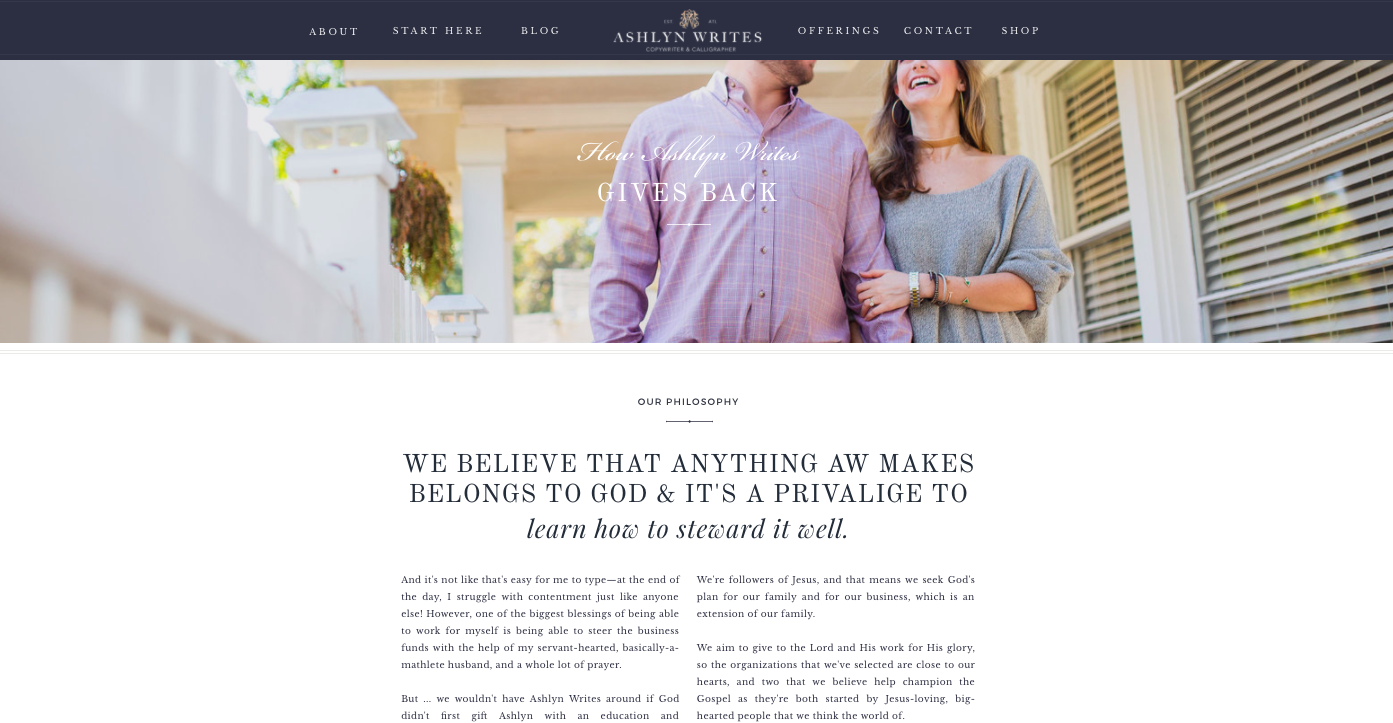Today, I want to talk about the ways your creative business gives back … because it’s hard to throw the rose quartz crystal on your desk these days without hitting a business with a social purpose.
“Has large corporate America figured out what small business has known for a long time? That giving back to the community is not only the right thing to do, but also a great way to get your name/product/promotion out there for free?” Fast Company posed the question.
Likely, you are.
BUT.
Are you communicating it well? Does anyone know about it? Does it have a home in your copy?

Part of the beauty of running small businesses is that we get to decide where every hour and every dollar goes. And when we meet our goals—for many of us around the holidays—it means giving some away.
I’m a Jesus-follower (which you’ve guessed if you follow me around the internets) but I’m also a marketer. I don’t believe it’s bad to communicate to others what you do and how you give back, especially during the holidays. There’s a time and a place for quiet giving, when the right hand does something the left doesn’t know about. But, I also think it’s important for your brand to be open publicly about how you give.
“As long as I’m doing things ethically, I think I have a moral obligation [as a businessman] to make as much money as I can. Why? So I can then GIVE as much as I possibly can.” – Michael Hyatt
Look at how my client Jenna talks about Guatemala … how former student Kelsey gives back CONSTANTLY through her business Paper & Oats.
“For most of history, ventures were founded upon one of two business models: A commercial enterprise would be established to maximize financial returns, or a not-for-profit or charity would be created to maximize social and environmental returns. However, over time, the way companies do business has transformed.”
Look at Nisolo. Warby Parker. TOMS.
Giving back isn’t something creative brands should overlook—80% of people believe businesses can take specific actions both to increase profits and improve the social or economic conditions of the community, according to a Harvard Business Review article.
Today, I want to talk about how to operate your business with social purpose. Let’s chat through:
- How to decide what your philanthropy should be
- My 4-part funnel tier to communicating your philanthropy
- Ideas for marketing your philanthropy efforts through your copy
Let’s go!
How to Decide What Your Philanthropy Should Be
My Harvard Business Review arrived a few months back.
“Consumers increasingly expect brands to have not just functional benefits—but a social purpose.”
Concur.
There’s Starbucks. Nike. Tecate. Emily Ley. Val Marie Paper. Pat Flynn. Melyssa Griffin. Rising Tide Society.
The list of brands that weave giving into their marketing communications goes on and on.
It’s all supported by renowned advertising agency Edelman’s latest trust barometer, showing 45% of people say their trust in business INCREASES if they believe it has contributed to the greater good.
But how do you decide where to give in your creative small business?!?
If you’re like me, you have all the ideas … AND all the feels. 😉
Here’s a quick framework to help you decide the right social purpose and philanthropy for your creative small business.
1. First, what’s your brand’s heritage?
My students know I’m crazy about asking their story. Why on earth they do what they do. Why this whole thing started. What was it that happened in your life that made you pick up those calligraphy pens? Decide to serve other brides? Grab a camera? Raise your hand and say you’d work with other entrepreneurs executing social media strategy?
For me, this was the easiest framework checkpoint. My business grew out of an eating disorder recovery, which—literally by God’s grace—we could afford thousands in medical bills because Wes had just gotten a new job and our house payments were low. It was tight, but we survived (ahem, survived. ;)) .
However, my heart aches for women who wouldn’t be able to spend what we did for therapists and doctors. Not to mention those who don’t think they have a “problem” and can’t catch symptoms earlier on.
Naturally, when my business made enough to both pay us and have money to spare, we started giving back to Southern Smash, an organization that works with collegiate women to dispell body image myths and shatter eating disordered thoughts in young women. The founder was also hospitalized for an eating disorder, and one chat with founder McCall Dempsy was all it took for me to realize that’s where I want my money to go.

2. What is relevant to your customers/clients?
What kinds of tensions are going on in their lives? Are they moms and a diaper drive during a hurricane tugs their heartstrings (looking at you, Emily Ley). Are you a family portraiture painter who gets sappy about children who don’t have these painted moments, and fostering/adoption makes your heartstrings sing?
“Be unashamed to bring your gifts to life to make a difference.” – Praise Santos
Think through where your clientele or customer is, and meet them there with something they care about.
[bctt tweet=”Be unashamed to bring your gifts to life to make a difference. – Praise Santos” username=”via AshlynSCarter”]
3. What are your product’s features?
Are you a sugar cookie company … but advocate for healthy body image and wellness with a well-deserved treat from time to time? Do you use ribbon, boxes, and wooden boards in your images and client gift boxes … but sustainably source them from a low-income development in your local community? Do you sell essential oils … but believe in teaching women how to nurture their bodies apart from harmful eating patterns? Is your business built on opening up conversations about racial relations, like IF Gathering has done with Be the Bridge?
Look at specific features of what you do, and see what the social nuances are there.
You may have a direct social need woven into your product.
My 4-Tier Funnel for Communicating Your Philanthropy
Ok. Putting my marketing hat on. Because you know I’m all about your message, and I want you to be clear.
Back to the whole right/left/hand thing. Some things you do in your business, no one needs to know about. That’s ok. The fact that you mentor budding entrepreneurs in the housing development down the street from you a few times a year. The fact that your client gifts are all from Noonday Collective.
There are also noble, good things that I DON’T think you need to communicate.
The way I see it, there are 4 tiers to your giving.
- 4 – Things that are good, you just don’t give to. I’m all about personal rules, and I explain it in this guide in the AW Shop.
- 3 – Things that you do, you just don’t talk about. Like praying over your business every month with your mastermind, or mailing a card to offer encouragement to someone each day.
- 2 – Things that you do, but they’re not headlines. Like ethically-sourced client gifts, or choosing to purchase office supplies from a company that gives to sex-trafficking relief efforts, mentoring your team members’ as they navigate marriage, etc.
- 1 – Things that you do, and they’re built into your message. Things that are central to your business, and ones that may even attract new customers. Like speaking publicly about eating disorder awareness or advocating for miscarriage awareness.
It’s important to think through this funnel-lens, because yes, it does relate to sales and consequently purchase decisions.
And that’s ok!! That’s us being responsible consumers. How many times has something influenced the way you vote with your dollars!?
Write down one idea for each part of the funnel, and get clear on how you communicate giving.
Ideas for marketing your small business’s philanthropy efforts through your copy
Ok. You worked through the funnel and arrived at the #1, bottom of the funnel result.
Now, ask yourself 3 questions:
- Is it going to seem relevant to your customers/clients?
- Will your tribe get the correlation between your brand and this thing
- Will it induce positive connection (not negative) from the people you want to attract?
Now that you have the socially responsible program you want to communicate through copy in your business this holiday season, let’s chat.

Photo: Nancy Ray
“Many small business owners may shy away from charitable giving, because they feel they don’t have the time, resources or staff to participate in a large giving campaign.”
You don’t HAVE to blow out Black Friday.
There are ways year round you can give!
Here are 5 ideas to get going:
- Give scholarship seats to your online coaching program or course. Decide how many you can give every year and do it!
- Take a day off from work and ask your team to give their time to an organization that they love.
- Donate your time—Callie Lindsey did the coolest adoption sessions for families that have been through the adoption process when she got back from Uganda.
- Partner with a local business or charity to
- During your next big launch, select an organization and set a goal for how much you’ll give to them (or give a percentage of your profits). Communicate it during your launch.
How does your business give back?
Click here to download the checklist to think through before you start marketing your philanthropy!
Reading Time: 7 Minutes Reading time: 6 min. Today, I want to talk about the ways your creative business gives back … because it’s hard to throw the rose quartz crystal on your desk these days without hitting a business with a social purpose. “Has large corporate America figured out what small business has known for a long time? […]




Hi Ashlyn. I just came across your site and you have great information. I tried downloading the 11 Questions Checklist for the Social Purpose, but there was not way to download it…no link. I would love to get this from you. Thank you for sharing.
Hey Veronica — I’m sorry the link you’re looking for is missing, and I’d love to get it to you, but I’m not quite sure where to direct you. I don’t have a resource that matches what you’re describing. If you can give me a bit more info, I’ll try to get you pointed in the right direction. xx. Ash